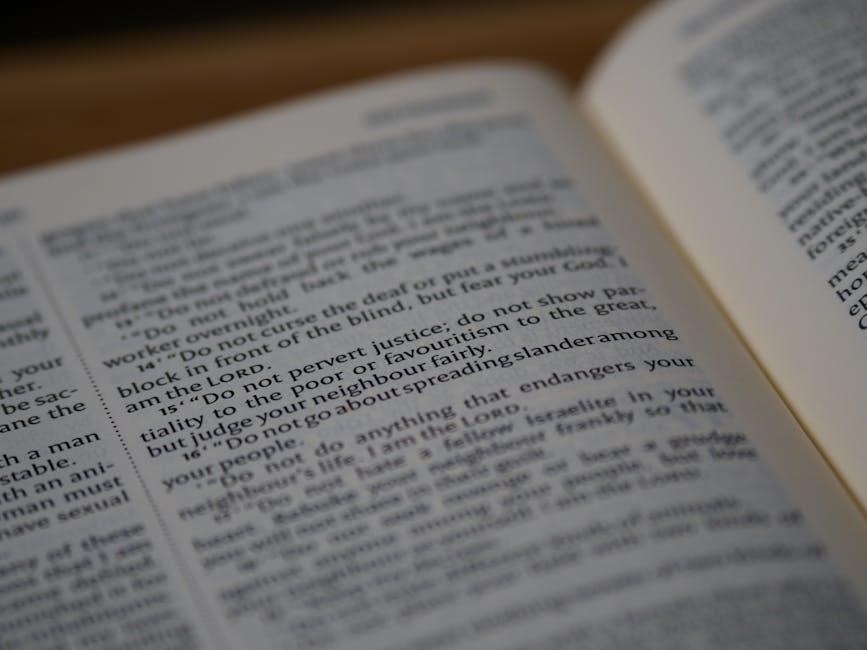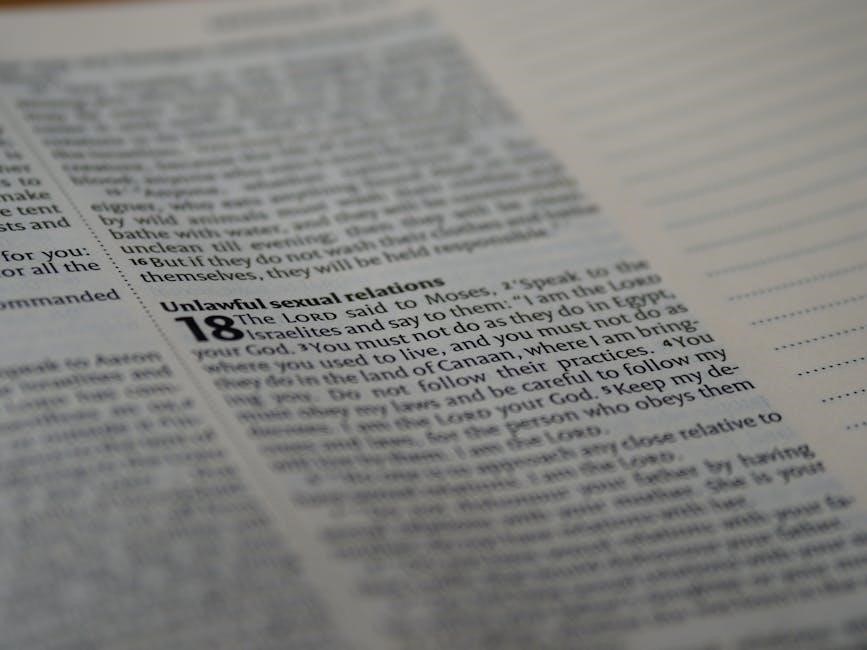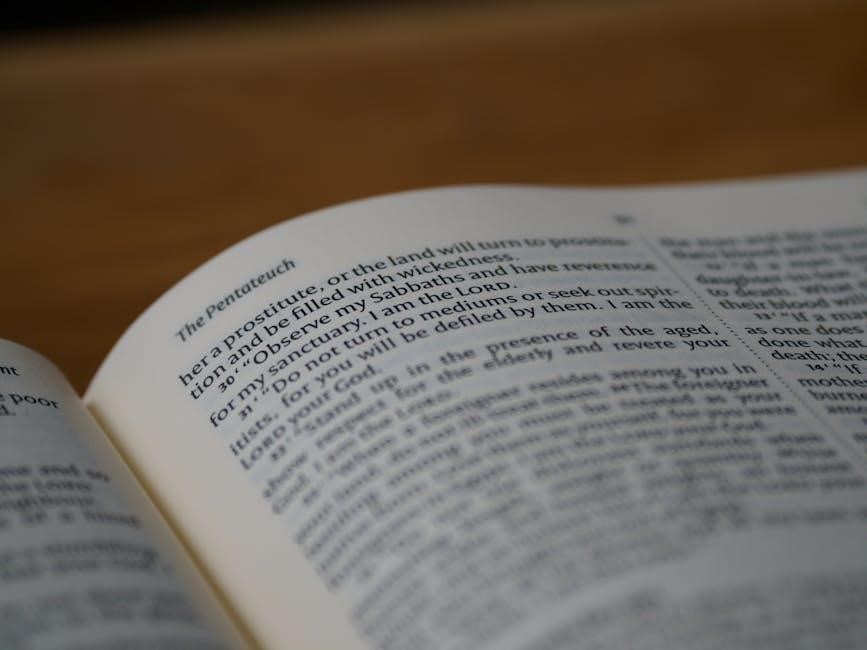Leviticus‚ the third book of the Bible‚ provides instructions for Israel after their liberation from Egypt‚ focusing on holiness‚ rituals‚ and purity laws to maintain a relationship with a holy God. It emphasizes the role of the priesthood‚ led by Aaron‚ in mediating between God and the people‚ ensuring their actions align with divine standards. The book serves as a guide for both individual and communal practices‚ aiming to restore and maintain a sacred space where God’s presence can dwell among His people.

Historical Context
Leviticus‚ the third book of the Bible‚ follows Israel’s liberation from Egypt‚ detailing God’s desire to dwell among His people and restore their relationship through sacred practices and laws.
2.1 Place in the Pentateuch
Leviticus is the third book of the Pentateuch‚ following Exodus and preceding Numbers. It serves as a central link between the Israelites’ liberation from Egypt and their journey toward the Promised Land. The book bridges the narrative of Exodus‚ which focuses on deliverance‚ and Numbers‚ which recounts the wilderness wanderings. Leviticus provides the theological and practical foundation for Israel’s life as a holy nation‚ emphasizing rituals‚ laws‚ and the priesthood. Its placement within the Pentateuch underscores its role in shaping Israel’s identity and relationship with God‚ ensuring the continuation of divine presence among His people. This positioning highlights its importance in the biblical narrative.
2.2 Transition from Exodus
Leviticus seamlessly follows Exodus‚ transitioning from the construction of the Tabernacle to the establishment of rituals and laws for maintaining God’s presence among the Israelites. Exodus concludes with the completion of the Tabernacle‚ symbolizing God’s dwelling place‚ while Leviticus opens with God speaking from within it‚ providing detailed instructions for worship‚ sacrifice‚ and purity. This transition emphasizes the shift from the physical structure to the spiritual practices necessary for sustaining a holy relationship with God. The laws and rituals outlined in Leviticus build upon the deliverance narrative of Exodus‚ equipping the Israelites to live as a consecrated people in covenant with their Redeemer.
Structure and Content
Leviticus is structured around laws‚ rituals‚ and purity codes‚ detailing sacrifices‚ priestly duties‚ and communal practices to maintain holiness and covenant fidelity‚ ensuring God’s presence among Israel.
3.1 Laws and Commandments
Leviticus outlines a comprehensive system of laws and commandments‚ emphasizing holiness‚ moral conduct‚ and rituals. These laws cover ceremonial practices‚ social behavior‚ and justice‚ aiming to maintain covenant fidelity with God. Central to these laws is the concept of sacrifice‚ such as the burnt offering‚ which symbolizes atonement and a pleasing aroma to the Lord. The laws also establish frameworks for justice‚ compassion‚ and purity‚ reflecting God’s holy nature. By adhering to these commandments‚ Israel ensures its relationship with God remains intact‚ fulfilling their covenant obligations and living as a holy people in a world separated for divine purposes.
3.2 Rituals and Sacrifices
Leviticus details elaborate rituals and sacrifices‚ central to Israel’s worship‚ emphasizing atonement‚ purification‚ and communion with God. The burnt offering symbolizes total devotion‚ while peace and sin offerings address specific needs. Rituals like the Day of Atonement‚ performed by priests‚ ensure national purification. These practices‚ often involving blood‚ highlight the seriousness of sin and the need for reconciliation. They also underscore the priesthood’s mediatorial role‚ ensuring rituals align with divine instructions. Through these sacred acts‚ Israel maintains covenant fidelity and experiences God’s forgiving grace‚ fostering a holy community and reinforcing their unique identity as God’s chosen people.
3.3 Purity Laws
Leviticus establishes detailed purity laws to maintain Israel’s holiness‚ reflecting God’s desire for His people to be distinct and sacred. These laws cover bodily discharges‚ skin conditions‚ and contact with the dead‚ categorizing individuals or objects as clean or unclean. Rituals for purification‚ such as washings and offerings‚ restore those deemed unclean. Additionally‚ dietary laws‚ like avoiding certain animals‚ reinforce separation from neighboring cultures. These regulations extend beyond physical hygiene‚ symbolizing moral and spiritual purity‚ and ensuring Israel’s readiness for divine presence. By adhering to these laws‚ the community upholds its covenant obligations and embodies God’s call to holiness in daily life.

Central Themes
Leviticus emphasizes holiness‚ sacrifice‚ and priesthood‚ highlighting God’s desire for His people to live distinctly as a sacred community. Forgiveness and covenant renewal are central‚ with rituals and laws guiding moral and spiritual purity‚ ensuring Israel’s relationship with a holy God remains intact.
4.1 Holiness
Holiness is a central theme in Leviticus‚ emphasizing God’s expectation for His people to live as a sacred community. The book teaches that holiness is not just ritual purity but a reflection of God’s character‚ requiring moral and spiritual integrity. Leviticus instructs Israel to be distinct from other nations‚ maintaining purity in daily life‚ worship‚ and relationships. This holiness is not just individual but communal‚ ensuring the presence of God remains among them. Through laws and rituals‚ Leviticus guides Israel in living a life set apart for God‚ highlighting the necessity of holiness to sustain their covenant relationship with Him.
4.2 Sacrifice
Sacrifice in Leviticus is a central act of worship‚ emphasizing atonement for sin and maintaining a right relationship with God. The book details various offerings‚ such as burnt‚ sin‚ and peace offerings‚ each serving specific purposes. Sacrifices symbolize devotion‚ forgiveness‚ and reconciliation‚ underscored by the shedding of blood to atone for sin. These rituals highlight the seriousness of sin and the need for substitutionary atonement. Leviticus also points to the ultimate sacrifice of Christ‚ fulfilling the OT sacrificial system. The priests‚ as mediators‚ play a crucial role in performing these rites‚ ensuring the community’s purity and restored fellowship with God through sacrificial acts.
4.3 Priesthood
The priesthood in Leviticus is a divine institution established by God to mediate between Himself and the Israelites. Aaron and his descendants were consecrated as priests‚ entrusted with performing sacrificial rites‚ maintaining the Tabernacle‚ and teaching God’s laws. Their role was essential for preserving the people’s holiness and ensuring the divine presence remained among them. Priests were responsible for offering sacrifices‚ blessing the people‚ and diagnosing ritual impurity. Their consecration involved elaborate ceremonies to set them apart as holy servants of God. The priesthood underscored the need for a mediator between a holy God and sinful humanity‚ reflecting the gravity of sin and the necessity of atonement. This institution emphasized divine order and the people’s reliance on God’s grace.

Key Events
Leviticus highlights pivotal moments like the consecration of Aaron‚ the tragic incident of Nadab and Abihu‚ and the institution of the Day of Atonement‚ shaping Israel’s sacred practices.
5.1 Consecration of Aaron
The consecration of Aaron and his sons as priests is a pivotal event in Leviticus‚ marking the establishment of the priesthood. Through rituals like anointing‚ sacrifices‚ and the placement of holy garments‚ Aaron was set apart to mediate between God and Israel. This ceremony emphasized purity and divine appointment‚ ensuring the priests could perform their sacred duties effectively. The process‚ detailed in Leviticus 8-9‚ culminated in the appearance of God’s glory‚ confirming Aaron’s role. This event underscored the importance of the priesthood in maintaining Israel’s relationship with God and highlighted the necessity of following divine instructions for sacred service.
5.2 Nadab and Abihu
Nadab and Abihu‚ sons of Aaron‚ tragically disregarded God’s instructions by offering unauthorized fire before the Lord‚ leading to their immediate death. This event‚ recorded in Leviticus 10‚ underscores the gravity of sin and the importance of adhering strictly to divine commands. Their actions were seen as a violation of sacred rituals‚ emphasizing the need for reverence and obedience in worship. The incident serves as a warning against presumption and the dangers of acting outside God’s prescribed order. It also highlights the solemn responsibility of the priesthood to maintain the holiness and integrity of their sacred role‚ ensuring God’s presence remains among Israel.
5.3 The Day of Atonement
The Day of Atonement‚ detailed in Leviticus 16‚ is the most significant ritual in the book‚ addressing the purification of Israel’s sins. On this day‚ the high priest enters the Holy of Holies to atone for the nation’s transgressions. Rituals include the sacrifice of a bull for the priest’s family‚ a goat for the people’s sins‚ and the symbolic removal of guilt via the scapegoat. This annual event emphasizes divine forgiveness‚ purification‚ and reconciliation‚ ensuring Israel’s covenant relationship with God remains intact. It starkly illustrates the need for atonement and the gravity of sin‚ while offering hope through divine mercy and restoration.

Symbolism in Leviticus
Leviticus is rich in symbolism‚ with the Tabernacle representing God’s divine presence among His people. Blood symbolizes atonement‚ while purity laws reflect spiritual holiness and separation from sin.
6.1 The Tabernacle
The Tabernacle in Leviticus symbolizes God’s dwelling place among His people‚ a sacred space where His presence resides. It serves as a physical representation of His covenant with Israel‚ constructed with precise details to reflect divine order and holiness. The Tabernacle’s design‚ from the outer court to the Holy of Holies‚ emphasizes separation and purity‚ with the Ark of the Covenant at its core. This structure is central to the rituals and sacrifices described in Leviticus‚ facilitating atonement and communion between God and humanity. The Tabernacle’s intricate design and ceremonial practices highlight the importance of reverencing God’s holiness and maintaining His presence within the community.
6.2 Blood and Atonement
Blood plays a central role in Leviticus as a symbol of life and atonement‚ representing the means by which sin is forgiven and reconciliation with God is achieved. The shedding of blood in sacrifices underscores the gravity of sin and the necessity of substitution to restore fellowship with a holy God. Leviticus details various rituals where blood is sprinkled or applied to cleanse individuals‚ objects‚ and the community‚ emphasizing its purifying power. This imagery highlights the cost of sin and the divine provision for forgiveness‚ ultimately pointing to the deeper theological truth of God’s mercy and His desire to dwell among His people despite their imperfections.
6.3 Clean and Unclean
In Leviticus‚ the distinction between clean and unclean is central to maintaining holiness and separation from impurity. Clean refers to what is pure and acceptable before God‚ while unclean signifies contamination or defilement. This classification applies to animals‚ people‚ and objects. For example‚ certain animals are deemed unclean for consumption‚ and individuals with specific bodily discharges or conditions are temporarily unclean. The laws emphasize separation from uncleanness to preserve the covenant community’s holiness. Rituals like purification ceremonies and washing are prescribed to restore cleanliness. This system teaches the Israelites to live in a way that honors God and reflects His holy nature‚ ensuring their distinctiveness among nations. These distinctions also symbolize spiritual purity and the need for moral separation. The concept reinforces the idea that holiness is both a state and a practice‚ requiring intentional living in accordance with divine standards. By adhering to these laws‚ the Israelites maintain their sacred covenant and relationship with God. This framework underscores the interconnectedness of physical‚ ritual‚ and moral purity in achieving a holy life. Ultimately‚ the clean and unclean distinctions serve as a practical guide for living a life consecrated to God‚ reflecting His character and will. The laws establish boundaries that protect the community from spiritual contamination and promote a culture of reverence for God’s holiness. Through these teachings‚ Leviticus equips the people of Israel to navigate their daily lives in a manner that aligns with God’s expectations‚ fostering both individual and communal sanctity. The clean and unclean distinction is thus a vital component of Leviticus’s broader theme of holiness‚ providing tangible practices that embody the abstract concept of being set apart for God. This dual classification system not only regulates physical and ritual purity but also shapes the moral and ethical fabric of the Israelite society. By understanding and applying these laws‚ the Israelites are reminded of their unique identity as God’s chosen people and their responsibility to reflect His holiness in all aspects of life. The clean and unclean distinctions in Leviticus are not merely arbitrary rules but a comprehensive framework for cultivating a holy community that mirrors God’s divine nature; Through these regulations‚ Leviticus emphasizes the importance of integrity‚ discipline‚ and devotion in maintaining a relationship with a holy God. The laws serve as both a guard against impurity and a guide for living a life that is pleasing to God‚ ensuring the Israelites’ continued fellowship with Him. In essence‚ the clean and unclean distinctions are a means to uphold the sacred covenant and to embody the holiness that defines God’s people. This system is a cornerstone of Leviticus’s teachings‚ providing practical wisdom for navigating the complexities of human life in a way that honors God and sustains His presence among His people. By adhering to these laws‚ the Israelites are empowered to live as a holy nation‚ set apart for God’s purposes. The clean and unclean distinctions are thus a profound expression of Leviticus’s central message: that holiness is not just a theological concept but a lived reality that permeates every aspect of human existence. Through these teachings‚ Leviticus offers a vision of life where every action‚ from the food one eats to the way one interacts with others‚ is infused with the pursuit of holiness. This vision is both challenging and transformative‚ calling the Israelites to embrace a life of intentional purity and dedication to God. The clean and unclean distinctions are a vital part of this vision‚ providing the necessary boundaries and guidelines for achieving a holy life. By understanding and applying these laws‚ the Israelites are equipped to live in a way that reflects God’s character and sustains their unique relationship with Him. The clean and unclean distinctions in Leviticus are thus a powerful tool for fostering a holy community‚ one that is set apart for God and committed to living according to His will. This system is a testament to the enduring relevance of Leviticus’s teachings‚ offering timeless wisdom for those seeking to live a life of holiness and devotion. The clean and unclean distinctions remind us that holiness is not merely a spiritual ideal but a practical reality that shapes every dimension of human life. Through these laws‚ Leviticus provides a comprehensive guide for living a life that is pleasing to God‚ ensuring that His people remain a holy and consecrated nation. The clean and unclean distinctions are a cornerstone of Leviticus’s message‚ emphasizing the importance of purity and separation in maintaining a sacred relationship with God. By adhering to these laws‚ the Israelites are able to uphold their covenant obligations and live as a people set apart for God’s glory. The clean and unclean distinctions are thus a profound expression of Leviticus’s central theme of holiness‚ offering both practical guidance and spiritual inspiration for living a life consecrated to God. This dual classification system is not only a regulatory framework but also a means of fostering a deep sense of reverence and awe for God’s holiness. Through the clean and unclean distinctions‚ Leviticus teaches the Israelites to approach life with intentionality and purpose‚ ensuring that every aspect of their existence aligns with God’s divine will. The laws are a reminder that holiness is not confined to ritual or ceremony but is a pervasive quality that should characterize all of life. By embracing these teachings‚ the Israelites are empowered to live as a holy people‚ reflecting God’s character in every aspect of their lives. The clean and unclean distinctions are thus a vital part of Leviticus’s vision for a holy community‚ offering practical wisdom for navigating the complexities of human existence in a way that honors God. Through these laws‚ Leviticus provides a timeless guide for living a life of purity‚ dedication‚ and holiness‚ ensuring that God’s people remain set apart for His purposes. The clean and unclean distinctions are a powerful reminder of the enduring relevance of Leviticus’s teachings‚ offering insights into the nature of holiness and the human condition. By understanding and applying these laws‚ the Israelites are able to live in a way that reflects God’s holiness and sustains their unique relationship with Him. The clean and unclean distinctions are thus a central element of Leviticus’s message‚ emphasizing the importance of purity and separation in maintaining a sacred covenant with God. Through these teachings‚ Leviticus equips the Israelites to live as a holy nation‚ dedicated to God’s glory and committed to upholding His standards of holiness in every aspect of life. The clean and unclean distinctions are a profound expression of Leviticus’s vision for a holy community‚ offering both practical guidance and spiritual inspiration for those seeking to live a life consecrated to God. This system is a testament to the enduring wisdom of Leviticus‚ providing a comprehensive framework for achieving and maintaining holiness in a world filled with impurity and sin. By adhering to these laws‚ the Israelites are able to embody the holiness that defines God’s people‚ ensuring their continued fellowship with Him and their fulfillment of His purposes. The clean and unclean distinctions are thus a vital part of Leviticus’s teachings‚ offering a powerful reminder of the importance of living a life that is pleasing to God and reflective of His holy character. Through these laws‚ Leviticus provides a timeless guide for navigating the complexities of human existence in a way that honors God and sustains His presence among His people. The clean and unclean distinctions are a cornerstone of Leviticus’s message‚ emphasizing the need for intentionality‚ purity‚ and dedication in all aspects of life. By understanding and applying these teachings‚ the Israelites are empowered to live as a holy people‚ set apart for God’s glory and committed to upholding His standards of holiness. The clean and unclean distinctions are thus a profound expression of Leviticus’s central theme of holiness‚ offering both practical wisdom and spiritual insight for living a life consecrated to God. This dual classification system is a powerful tool for fostering a holy community‚ one that is dedicated to reflecting God’s character

The Role of Priests
Priests‚ led by Aaron‚ were mediators between God and Israel‚ responsible for sacrifices‚ rituals‚ and teaching the law. Their purity and sanctity were vital for maintaining God’s presence among the people.
7.1 Responsibilities
Priests in Leviticus were responsible for performing sacrifices‚ ensuring purity‚ and mediating between God and Israel. They conducted burnt offerings‚ sin offerings‚ and other rituals to atone for sin; Priests also taught the law‚ maintaining its integrity and instructing the people in holy living. Their role included overseeing rituals‚ such as the Day of Atonement‚ and ensuring the Tabernacle’s sanctity. They were to exemplify holiness‚ as their actions directly impacted Israel’s relationship with God. Their duties were exclusive‚ requiring strict adherence to purity laws to avoid defiling sacred spaces or objects‚ as seen in the tragic example of Nadab and Abihu.
7.2 Modern Relevance
Leviticus’ timeless principles‚ such as holiness‚ purity‚ and sacrifice‚ continue to inspire modern spiritual practices. Its emphasis on ethical living‚ forgiveness‚ and community unity resonates today. The concept of sacred spaces and rituals reminds us of the importance of intentional worship. While specific laws may not apply directly‚ the book’s focus on moral integrity and humility offers guidance for personal and communal life. It challenges modern believers to reflect on their relationship with God and others‚ emphasizing compassion‚ justice‚ and the pursuit of holiness in everyday life. Leviticus’ teachings on atonement and forgiveness remain central to Christian theology‚ highlighting God’s desire for reconciliation and restoration.

Connection to Other Biblical Books
Leviticus connects seamlessly with Exodus‚ detailing rituals and laws for Israel’s worship. It also transitions into Numbers‚ which narrates the implementation of these laws. The book’s themes of sacrifice and atonement foreshadow the New Testament’s depiction of Jesus Christ as the ultimate sacrifice‚ fulfilling the Levitical system.
8.1 Exodus
Leviticus flows directly from the events of Exodus‚ where Israel was liberated from Egypt and God established a covenant with them. Exodus concludes with the construction of the Tabernacle‚ a sacred space for God’s presence‚ while Leviticus provides the instructions for its use. The book bridges the transition from liberation to legislation‚ focusing on how the Israelites should worship and live as a holy nation. Leviticus expands on Exodus by detailing the laws‚ rituals‚ and priesthood necessary for maintaining a relationship with God. This connection emphasizes the shift from God’s deliverance to the practical application of His will in the lives of His people.
8.2 Numbers
Leviticus and Numbers are closely connected‚ as Numbers continues the narrative of Israel’s journey after receiving the laws in Leviticus. While Leviticus focuses on rituals‚ purity‚ and holiness‚ Numbers describes the practical application of these principles during Israel’s wilderness wanderings. The book of Numbers bridges the gap between the Sinai wilderness and the Promised Land‚ showing how the laws and priesthood established in Leviticus were lived out in the community. The transition from Leviticus to Numbers highlights the ongoing role of the priesthood in guiding the people and maintaining God’s presence among them. This connection underscores the importance of obedience and faithfulness in fulfilling God’s covenant promises.
8.3 New Testament
The book of Leviticus finds its ultimate fulfillment in the New Testament through Jesus Christ. The sacrifices and rituals described in Leviticus symbolize Christ’s atonement for humanity. In Hebrews‚ Jesus is portrayed as the perfect High Priest‚ offering Himself as the final sacrifice‚ replacing the need for repeated offerings. The concept of holiness in Leviticus reflects God’s desire for His people to be set apart‚ a theme carried forward in the New Testament’s call to live a life transformed by faith. The Day of Atonement in Leviticus foreshadows Christ’s sacrifice‚ which provides complete forgiveness and restores humanity’s relationship with God. Thus‚ Leviticus’ teachings are fulfilled in Christ‚ who embodies the true Tabernacle and sacrifice‚ making the old covenant rituals obsolete.

Theological Significance
Leviticus underscores God’s holiness‚ humanity’s need for atonement‚ and the covenant relationship‚ emphasizing sacrifice and purity to restore a right relationship with God‚ central to theological understanding.
9.1 Presence of God
Leviticus emphasizes God’s desire to dwell among His people‚ establishing the tabernacle as a sacred space for His presence. Through rituals and sacrifices‚ Israel maintained this divine relationship‚ ensuring God’s holy presence remained central to their community. The book highlights the importance of purity and holiness to sustain this connection‚ reflecting God’s transcendence and immanence. Leviticus teaches that God’s presence is both a privilege and a responsibility‚ requiring obedience to His laws to preserve the covenant bond. This theme underscores the theological heart of Leviticus‚ showcasing God’s relational nature and humanity’s role in honoring His holy presence.
9.2 Forgiveness
Leviticus provides a system for obtaining forgiveness through sacrifices and rituals‚ emphasizing the need for atonement to restore the relationship between God and humanity. The book outlines various offerings‚ such as burnt and sin offerings‚ to address sin and impurity. The shedding of blood‚ symbolizing life‚ is central to these rituals‚ highlighting the cost of sin and the means of forgiveness. The Day of Atonement‚ in particular‚ serves as a collective purification for Israel‚ reinforcing God’s mercy and willingness to forgive. These practices underscore the theological importance of forgiveness as a divine act‚ rooted in God’s covenant faithfulness and love for His people.
9.3 Covenant
Leviticus profoundly emphasizes the covenant relationship between God and Israel‚ established through divine promises and obligations. The book serves as a guide for maintaining this sacred bond‚ with laws and rituals designed to uphold Israel’s identity as God’s chosen people. Central to this covenant is the concept of holiness‚ reflecting God’s nature and expectations for His people. The Tabernacle‚ as a symbol of God’s presence‚ underscores the covenant’s communal dimension‚ while purity laws and sacrifices reinforce individual and collective accountability. Leviticus thus frames the covenant as both a privilege and a responsibility‚ ensuring Israel’s distinctive role and relationship with God amidst the nations.

Practical Applications
Leviticus provides practical guidance for living a holy life‚ emphasizing ethical behavior‚ community accountability‚ and reverence for God’s presence‚ applicable in personal and communal contexts today.
10.1 Personal Holiness
Leviticus emphasizes personal holiness as a reflection of God’s character‚ urging individuals to live ethically‚ avoid sin‚ and maintain integrity. It teaches that holiness is not just ritualistic but a way of life‚ requiring separation from impurity and dedication to God. The book guides individuals in making choices that align with divine standards‚ fostering a deeper relationship with Him. Personal holiness involves reverence for God’s commands‚ self-discipline‚ and a commitment to righteousness‚ creating a sacred life that honors His presence and fosters spiritual growth.
10.2 Community Life
Leviticus emphasizes the importance of community life‚ with laws and practices designed to promote unity and social justice. It encourages shared responsibility‚ such as caring for the vulnerable‚ including the poor‚ widows‚ and orphans. The book also outlines communal rituals and festivals that foster solidarity and collective worship. Leviticus teaches that a harmonious society is built on mutual respect‚ fairness‚ and adherence to divine standards. By following these principles‚ the Israelites were to create a community that reflected God’s holiness and served as a witness to His presence among them. This focus on collective life underscores the interconnectedness of individuals within the covenant.

Relevance in Modern Times
Leviticus remains relevant today‚ offering timeless principles that transcend its historical context. Its emphasis on holiness‚ forgiveness‚ and community reflects universal human needs. The book’s teachings on purity‚ sacrifice‚ and ethical living inspire modern discussions on morality and social justice. Leviticus also highlights the importance of integrity‚ compassion‚ and accountability‚ which are essential for building strong relationships and societies. While its rituals may not be directly applicable‚ the underlying themes of reverence for God and care for others continue to resonate. Leviticus encourages believers to live intentionally‚ fostering a deeper connection with the divine and a commitment to living out faith in everyday life.
Leviticus serves as a foundational book in the Bible‚ bridging the narrative of Exodus and Numbers while providing profound theological truths. Its focus on holiness‚ sacrifice‚ and the priesthood underscores God’s desire for a sacred relationship with His people. The book’s detailed laws and rituals‚ though rooted in ancient Israel‚ offer timeless lessons on morality‚ purity‚ and worship. Leviticus also points to the ultimate sacrifice of Jesus Christ‚ fulfilling its symbolic practices. As a guide for living a life pleasing to God‚ Leviticus remains a vital text for understanding divine expectations and the transformative power of faith. Its teachings continue to inspire believers today‚ emphasizing reverence‚ forgiveness‚ and covenant loyalty.